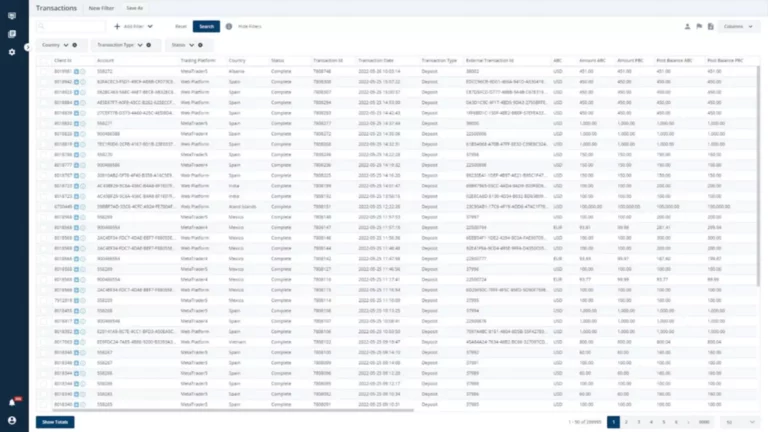Regular audits help identify and rectify vulnerabilities, ensuring good contracts function as intended and reduce the risk of exploits. Implementing strong security measures like code evaluations, formal verification, and bug bounties fosters trust and safeguards the decentralized ecosystem. Smart contracts, while revolutionary in their ability to automate transactions on the blockchain, come with inherent dangers and vulnerabilities.
As users trade assets within the pool, the AMM algorithm recalibrates the prices to reflect the impression of the trades on the overall pool liquidity. This algorithmic adjustment ensures that the prices throughout the pool remain aggressive and near the market fee. Liquidity swimming pools have emerged as a revolutionary concept in decentralized finance (DeFi), providing a decentralized and environment friendly answer to the age-old liquidity drawback. These swimming pools have significant implications for the financial ecosystem, bringing forth varied advantages and alternatives for participants. Interoperability and cross-chain liquidity are pivotal future developments in crypto, but they also present significant challenges.
Key Ideas In Liquidity Pools
This algorithm helps handle the cost and ratio of tokens in accordance with demand. Thanks to liquidity pools, there are no longer vendors asking for twice the market price or patrons willing to pay below-average reductions. Since the liquidity pool is a set of assets secured by a wise contract, their values are continuously updated in accordance with change charges. AMM-based liquidity pools use automated, blockchain-powered technology where users can swap digital property with out relying on centralized entities.
From basic Constant Product pools to the versatile Hybrid Pools, every has options that attraction to completely different suppliers. But then got here Automated Market Makers (AMMs), which was proposed by Vitalik Buterin in a 2016 publish. This marked a departure from order books and into liquidity pools that rely on market pricing and algorithms, with one of many important DEXs that popularized liquidity pools being Uniswap.
- Uniswap is one of the most popular decentralized exchanges that employs liquidity pools on the Ethereum network.
- For example, many DEX’s make use of a “constant product formula” to maintain token value ratios.
- Additionally, good contract vulnerabilities, hacking dangers, and sudden modifications in market circumstances can expose liquidity suppliers to potential financial losses.
- If we enter the USDC/ETH liquidity pool, we get all the info wanted to become liquidity suppliers.
- The number of liquidity tokens obtained by a liquidity provider is proportional to their contribution to the pool.
- Sushiswap’s unique function is its use of Automated Market Making (AMM), which enables users to earn charges by providing liquidity to token pairs.
Understanding slippage and actively managing liquidity swimming pools are crucial for optimizing trading strategies on constant product platforms. Liquidity suppliers are just like the lifeblood of monetary markets as a outcome of they play a key position in making certain the provision and stability of liquidity. Their primary function is to provide belongings or funds to liquidity pools, facilitating trading and guaranteeing that buyers and sellers can execute transactions effectively. By contributing their property, liquidity providers enhance market depth and scale back price volatility. In DEXs, belongings are priced primarily based on an algorithm as a substitute of via an order e-book like in conventional exchanges.
How Do Crypto Liquidity Pools Work In 2023-2024?
Since liquidity pools operate in an intense industry where buyers frequently look for elevated returns elsewhere, providing engaging liquidity may be difficult. Although liquidity pools clearly present numerous advantages and top-quality applications, they also carry significant drawbacks. DeFi needs no introduction because of its relevance within the blockchain sphere. This different monetary system allows customers to leverage their cryptocurrency holdings into large earnings. It is further outperforming standard financial systems in producing worth for investors.

It is crucial for the smooth operation of markets because it permits individuals to enter and exit positions expeditiously, lowering transaction prices and market volatility. There won’t be much change for crypto liquidity swimming pools until DeFi addresses the transactional facet of liquidity. Now, let’s take a glance at the three most used crypto liquidity pools as of 2022, together with an outline of their key characteristics. This article discusses the definition of a liquidity pool, its upsides and disadvantages, the way to join a liquidity pool, and the most popular liquidity swimming pools so far.
In this Learn Center submit, we’ll stroll you through how liquidity swimming pools energy decentralized exchanges and provide liquidity for buying and selling and different uses. Uniswap is doubtless certainly one of the most popular decentralized exchanges that employs liquidity pools on the Ethereum community. It permits customers to commerce ERC-20 tokens immediately from their wallets with out the necessity for an intermediary. As the DeFi landscape matures, liquidity swimming pools will likely turn out to be extra refined, providing progressive features and techniques to optimize capital efficiency. We can expect the emergence of cross-chain liquidity swimming pools, enabling seamless interoperability between completely different blockchain networks.
How To Be A Part Of A Liquidity Pool?
As you’d expect, any time you lock your crypto funds into a liquidity pool, you turn into a liquidity provider (LP). This is the essence of yield farming, with liquidity swimming pools as yield farms and liquidity providers as yield farmers. If you have https://www.xcritical.com/ been to trade USD for EUR, a market maker like JP Morgan would be the intermediary that would give a quote for ask and bid costs in addition to supply liquidity.

However, implementing and adopting these options on a big scale requires widespread consensus, user schooling, and seamless integration with current infrastructure. Overcoming these challenges will pave the way in which for a extra scalable and efficient crypto ecosystem. This protocol optimizes liquidity provisioning by using convex tokens, unlocking additional rewards and incentives. By offering a seamless expertise and promoting sustainable liquidity, Convexity Protocol has gained recognition as a number one platform inside the thriving ecosystem of liquidity protocols. The constant product formulation, exemplified by platforms like Uniswap, revolutionizes worth discovery and pool balance upkeep. This algorithmic method ensures a continuous product of reserves in a liquidity pool, allowing for environment friendly buying and selling without counting on centralized intermediaries.
The swappers pay a small payment for utilizing the pool, and this fee is distributed among the LPs to incentivize them for the service they provide. In different words, the more assets LPs lock up, the more LP tokens they obtain, and the higher proportion of charges they collect. To start a liquidity pool, users deposit equal values of two tokens into the pool, creating what is known as a buying and selling pair. For instance, if you want to create a liquidity pool for BTC and ETH, you’d deposit an equal value of each assets. To begin, liquidity of an asset is tremendous essential for determining how easily it can be bought, offered and exchanged.
Then, connect your pockets to the platform and choose the specific liquidity pool you want to join. Pay attention to elements corresponding to buying and selling fees, liquidity, and token pairs before clicking the “Provide Liquidity” option. Once your transaction is processed on the blockchain, you’ll obtain a confirmation as quickly as it is completed (this might take a while, depending on network congestion). In change for your contribution to the pool, you’ll receive liquidity tokens representing your share of the reserve. Those who contribute their property and form the pool are known as liquidity suppliers (LPs). Usually, LPs are regular buyers and customers in search of to capitalize on the incentives that come with such forms of investing.
If you’ve ever puzzled where to stake your crypto assets, DeFi is a rising sector with loads of nice options to select from. Although changing into a liquidity supplier can be risky, as the old adage goes, «No danger, no reward.» The variety of liquidity tokens acquired by a liquidity provider is proportional to their contribution to the pool. For instance, when you contribute 1% of the pool’s whole liquidity, you’d receive LP tokens that represent 1% of the entire issued LP tokens. In this conventional mannequin, a market maker creates markets by shopping for and promoting crypto directly from crypto traders. AMMs dynamically modify the prices of assets based on supply and demand, ensuring that the pool maintains a balanced allocation of the 2 tokens.
Be sure to double check that you’re connecting to a sound DEX, as there are heaps of scams that target consumer wallets when they’re undertaking this step. Watch out for tasks the place designers can modify the rules of the pool the finest way they want. An govt code or different how does liquidity work in crypto special access to the good contract code could also be out there to developers. This might give them the chance to trigger hurt, corresponding to seizing the pool’s cash. To get a better understanding of how such a system works in the true world, let’s check out the following example.

When a user interacts with a liquidity pool, they interact instantly with the smart contract, which eliminates the need for an middleman or an overseeing get together. The transparency and trustlessness of sensible contracts enable safe and environment friendly transaction execution within liquidity swimming pools. These are algorithmic protocols that facilitate the automatic trading of property throughout the pool. Decentralized Finance Applications — extend beyond easy buying and selling and lending.
Uniswap, a decentralized change protocol built on Ethereum, revolutionized the world of liquidity provision. Uniswap permits customers to trade ERC-20 tokens immediately from their wallets by eliminating intermediaries. Its unique automated market maker (AMM) model makes use of sensible contracts to facilitate trades, with liquidity providers pooling their tokens into liquidity reserves. In conclusion, decentralized exchanges, yield farming platforms, finance applications, and cross-chain liquidity pools have revolutionized the financial panorama.
Bancor achieves this by way of an autonomous pricing mechanism based on good contracts and a decentralized network of liquidity providers. However, slippage, the difference between the anticipated and actual execution value, can impression trades on these decentralized exchanges. High slippage arises when liquidity is proscribed, resulting in potential losses or reduced positive aspects for merchants.
